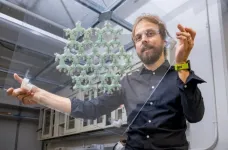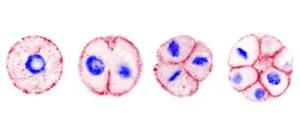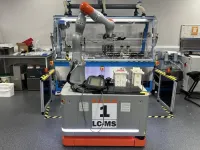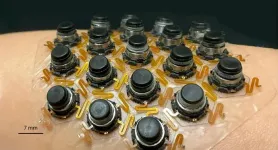(Press-News.org) AMHERST, Mass. — University of Massachusetts Amherst researchers have discovered a new way to detect per- and polyfluoroalkyl substances (PFAS) in water. This marks an important step forward in creating testing devices that are simpler, more cost-effective, faster and generally more accessible than existing methods.
PFAS, the so-called forever chemicals, have been recognized as a concerning pollutant.
These chemicals persist in the environment because they resist breaking down and pose significant health threats. Exposure to these chemicals is linked to various cancers (including kidney, testicular, breast, ovarian, prostate, thyroid and childhood leukemia), liver and heart damage, and developmental damage to infants and children.
Earlier this year, the Environmental Protection Agency (EPA) announced the first-ever national safety standard for PFAS in drinking water at 4 ppt. “PPT – that means parts per trillion. That means in a trillion molecules in water, only 4 molecules are PFAS. And then we need to be able to detect even those few,” explains Chang Liu, associate professor of biomedical engineering at UMass Amherst and corresponding author of the paper published in the journal Science Advances that describes their new method.
The gold standard for testing PFAS is currently liquid chromatography combined with mass spectrometry. However, this method requires million-dollar equipment and complicated extraction steps. And, it is not portable. “In addition, the stubborn persistence of PFAS residues can diminish the sensitivity of these instruments over time,” says Xiaojun Wei, first author of the paper and research assistant professor at UMass Amherst.
Their study demonstrates that a small, inexpensive device is feasible for identifying various PFAS families and detecting PFAS at levels as low as 400 ppt. While this proof-of-concept stage invention does not reach the same level of sensitivity or the breadth of PFAS types that can be detected compared to mass spectrometry, the researchers see high potential for its impact.
“We’re bringing the cost of the instrument from the scale of a million dollars to a few thousand,” says Liu. “We need better technology for detecting PFAS — more accessible, more affordable and easier to use. And more testing that’s on site. That’s the motivation.”
The researchers also see an application to use this method as a first-screening tool to identify the water that poses the greatest risks to human health.
Their testing device works by adding a molecule called cyclodextrin to a small device that is typically used for sequencing DNA, called a nanopore. The “host-guest” interaction between cyclodextrin and PFAS has been well documented, but Liu explains that no one had ever combined it with a nanopore for detection. “Now we’re using one of these molecules called HP-gamma-Cyclodextrin as an adapter in an alpha-Hemolysin nanopore,” he says, effectively creating a PFAS detector.
Liu hopes that their research will help raise awareness to the hazards of PFAS and eventually lead to a commercialized portable PFAS detector for water monitoring in the field.
END
New PFAs testing method created at UMass Amherst
The discovery is a promising step toward making water testing more affordable, portable and accessible
2024-11-06
ELSE PRESS RELEASES FROM THIS DATE:
Asteroid grains shed light on the outer solar system’s origins
2024-11-06
Tiny grains from a distant asteroid are revealing clues to the magnetic forces that shaped the far reaches of the solar system over 4.6 billion years ago.
Scientists at MIT and elsewhere have analyzed particles of the asteroid Ryugu, which were collected by the Japanese Aerospace Exploration Agency’s (JAXA) Hayabusa2 mission and brought back to Earth in 2020. Scientists believe Ryugu formed on the outskirts of the early solar system before migrating in toward the asteroid belt, eventually settling into an orbit between Earth and Mars.
The team analyzed Ryugu’s particles for signs of any ancient magnetic field that might have been present ...
Grant supports finding brain-inspired ways to develop low-energy computing
2024-11-06
The human brain is an astonishing organ, as any neuroscientist can attest. And its ability to collect, store, analyze and use information is intriguing to physicists, engineers and computer scientists, too.
Benjamin Jungfleisch, associate professor of physics at the University of Delaware, is among them.
Jungfleisch, who joined UD’s faculty in 2018, is an expert in magnon spintronics. He uses lasers to explore the dynamics of magnetic nanostructures — tiny magnets that can be used to ...
People engaging in self-harm find support on Reddit. But is that community helping them?
2024-11-06
A new study from the University of Georgia suggests people posting in Reddit’s r/selfharm community are likely seeking support for negative emotions.
While sharing traumatic events online can be cathartic, the researchers caution that subreddits can’t provide the same type of mental health help and support face-to-face interactions and professional help can.
“We don’t know the accuracy of the information that’s being shared in these communities about nonsuicidal self-injury,” ...
The egg or the chicken? An ancient unicellular says egg!
2024-11-06
Chromosphaera perkinsii is a single-celled species discovered in 2017 in marine sediments around Hawaii. The first signs of its presence on Earth have been dated at over a billion years, well before the appearance of the first animals. A team from the University of Geneva (UNIGE) has observed that this species forms multicellular structures that bear striking similarities to animal embryos. These observations suggest that the genetic programmes responsible for embryonic development were already present before the emergence of animal life, ...
Coping and resilience aids parents of disabled children, study says
2024-11-06
OXFORD, Miss. – For parents of children with disabilities, finding time to focus on themselves may be difficult. However, a new study finds that the right coping strategies and resilience can significantly help manage the challenges of raising children with special needs.
That is the key finding from research published in the International Journal of Developmental Disabilities that studied families with neurodevelopmentally disabled children in Ghana to see what helps parents cultivate healthy, happy lives for themselves and their children.
“Our main interest ...
Lupus Research Alliance announces inaugural recipients of Translational Bridge Award
2024-11-06
New York, NY. November 6, 2024. The Lupus Research Alliance (LRA) is excited to announce the first-ever recipients of the Translational Bridge Award (TBA), established this year to accelerate the translation of groundbreaking research into potential treatments and diagnostics for lupus. The award aims to propel high-potential projects from LRA-funded foundational discoveries with strong commercialization potential or an opportunity for clinical evaluation. Five exceptional researchers have been awarded the 2024 Translational Bridge Award to tackle pressing ...
Brain stars hold our memories
2024-11-06
A study published in Nature by researchers at Baylor College of Medicine changes the way we understand memory. Until now, memories have been explained by the activity of brain cells called neurons that respond to learning events and control memory recall. The Baylor team expanded this theory by showing that non-neuronal cell types in the brain called astrocytes – star-shaped cells – also store memories and work in concert with groups of neurons called engrams to regulate storage and retrieval of memories.
“The prevailing idea is that the formation and recall of memories only involves neuronal engrams that are activated by certain ...
Imaging nuclear shapes by smashing them to smithereens
2024-11-06
UPTON, N.Y. — Scientists have demonstrated a new way to use high-energy particle smashups at the Relativistic Heavy Ion Collider (RHIC) — a U.S. Department of Energy (DOE) Office of Science user facility for nuclear physics research at DOE’s Brookhaven National Laboratory — to reveal subtle details about the shapes of atomic nuclei. The method, described in a paper just published in Nature, is complementary to lower energy techniques for determining nuclear structure. It will add depth to scientists’ understanding of the nuclei that make up the ...
AI-driven mobile robots team up to tackle chemical synthesis
2024-11-06
Researchers at the University of Liverpool have developed AI-driven mobile robots that can carry out chemical synthesis research with axtraordinairy efficiency.
In a study publishing in the journal Nature, researchers show how mobile robots that use AI logic to make decisions were able to perform exploratory chemistry research tasks to the same level as humans, but much faster.
The 1.75-meter-tall mobile robots were designed by the Liverpool team to tackle three primary problems in exploratory chemistry: performing the reactions, ...
New haptic patch transmits complexity of touch to the skin
2024-11-06
A Northwestern University-led team of engineers has developed a new type of wearable device that stimulates skin to deliver various complex sensations.
The thin, flexible device gently adheres to the skin, providing more realistic and immersive sensory experiences. Although the new device obviously lends itself to gaming and virtual reality (VR), the researchers also envision applications in healthcare. For example, the device could help people with visual impairments “feel” their surroundings or give feedback to people with prosthetic limbs.
The ...
LAST 30 PRESS RELEASES:
An ‘illuminating’ design sheds light on cholesterol
Who is more likely to get long COVID?
Study showcases resilience and rapid growth of “living rocks”
Naval Research Lab diver earns Office of Naval Research 2025 Sailor of the Year
New Mayo-led study establishes practical definition for rapidly progressive dementia
Fossil fuel industry’s “climate false solutions” reinforce its power and aggravate environmental injustice
Researchers reveal bias in a widely used measure of algorithm performance
Alcohol causes cancer. A study from IOCB Prague confirms damage to DNA and shows how cells defend against it
Hidden viruses in wastewater treatment may shape public health risks, study finds
Unlock the power of nature: how biomass can transform climate mitigation
Biochar reshapes hidden soil microbes that capture carbon dioxide in farmland
Reducing saturated fat intake shows mortality benefit, but only in high-risk individuals
Manta rays create mobile ecosystems, study finds
Study: Mixed results in using lipoic acid to treat progressive multiple sclerosis
Norbert Holtkamp appointed director of Fermi National Accelerator Laboratory
New agentic AI platform accelerates advanced optics design
Biologists discover neurons use physical signals — not electricity — to stabilize communication
Researchers discover that a hormone can access the brain by hitchhiking
University of Oklahoma researcher awarded funding to pursue AI-powered material design
Exploring how the visual system recovers following injury
Support for parents with infants at pediatric check-ups leads to better reading and math skills in elementary school
Kids’ behavioral health is a growing share of family health costs
Day & night: Cancer disrupts the brain’s natural rhythm
COVID-19 vaccination significantly reduces risk to pregnant women and baby
The role of vaccination in maternal and perinatal outcomes associated with COVID-19 in pregnancy
Mayo Clinic smartwatch system helps parents shorten and defuse children's severe tantrums early
Behavioral health spending spikes to 40% of all children’s health expenditures, nearly doubling in a decade
Digital cognitive behavioral treatment for generalized anxiety disorder
Expenditures for pediatric behavioral health care over time and estimated family financial burden
Air conditioning in nursing homes and mortality during extreme heat
[Press-News.org] New PFAs testing method created at UMass AmherstThe discovery is a promising step toward making water testing more affordable, portable and accessible





